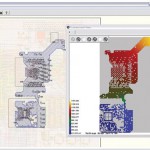September 10, 2010
Microelectromechanical systems (MEMS) manufacturing continues to be dogged by a technologically and economically inefficient landscape where too many products demand their own bespoke processes and packages. However, the last three years have seen third-party foundries gain more influence over the sector, bringing greater demands for reuse and DFM considerations, earlier in the design flow. The [...]
September 10, 2010
Timing closure is a key challenge for today’s complex system-on-chip designs. Static timing analysis (STA) tools automatically analyze signal paths in a design and identify timing-critical paths that limit the clock frequency that can be achieved. Paths that can never be functionally activated or that require multiple cycles for correct operation can be identified as [...]
September 10, 2010
Simulation speed is a key issue for the virtual prototyping (VP) of multiprocessor system-on-chips (MPSoCs). The SystemC transaction level modeling (TLM) 2.0 scheme accelerates simulation by using interface method calls (IMC) to implement communication between hardware components. Acceleration can also be achieved using parallel simulation. Multicore workstations are moving into the computing mainstream, and symmetric [...]
September 10, 2010
The use of multicore processors is on the rise to meet inexorable demand for increasingly sophisticated functionality in embedded systems. Hardware virtualization technology provides a complementary and game-changing approach to maximizing the utility of that extra silicon horsepower. The Power Architecture has included hardware virtualization support since 2001 in its server-based instruction set architecture (ISA). [...]
September 10, 2010
This issue analyzes two of the most dynamic markets in electronics: embedded systems and microelectromechanical systems (MEMS). And both articles tell a familiar tale.
Article | Tags:
September 10, 2010
Signal integrity (SI) issues have been around for a while, the result of ever-faster edge rates. Both SI and PI problems manifest themselves as data errors. Indeed, PI problems are often misdiagnosed as SI problems. As such, an understanding of power delivery issues is essential to the success of any board project, as is a [...]
June 1, 2010
Knowing where your application is consuming resources is a crucial step in minimizing energy usage. The article describes a toolset developed by high-profile ARM-based microcontroller (MCU) start-up Energy Micro that helps to achieve this overarching goal within the context of a parallel move to 32bit MCU resolution.
June 1, 2010
The demands of manufacturing closure at advanced process nodes make the traditional design-then-fix flow unmanageable. At 28nm and below, designers need a solution that can address manufacturing issues at any point in the design process, enabling a true correct-by-construction methodology. An effective solution must provide design-rule-check and design-for-manufacturing analysis using the actual foundry-approved signoff rules [...]
June 1, 2010
GateRocket's RocketDrive facilitates integration of an FPGA into an HDL simulator to provide a "native" execution of a design on its target FPGA device. The companion RocketVision tool provides software-debugging capabilities that directly identify and enable the rapid resolution of bugs. This article considers the use of these tools in a "device native" verification and [...]
June 1, 2010
The limited cell count of standard cell libraries is restricting the performance that designs can achieve without resorting to expensive and time-consuming techniques. This article describes the addition of extended cell libraries and novel synthesis tools to a traditional RTL-to-GDSII flow in a new methodology that helps to overcome this performance brake. The technique is [...]
